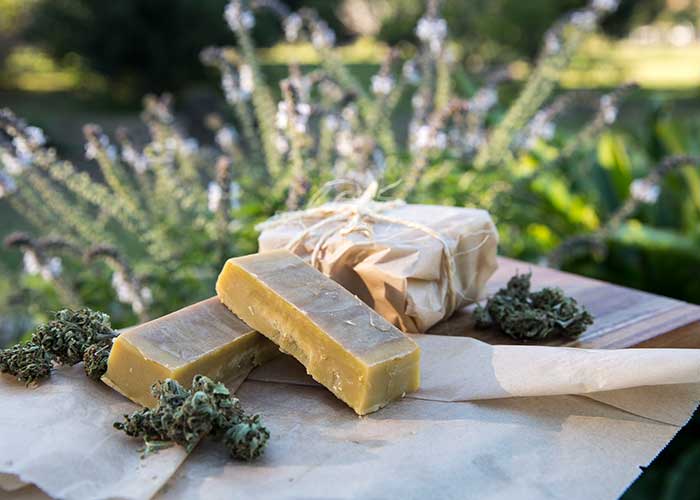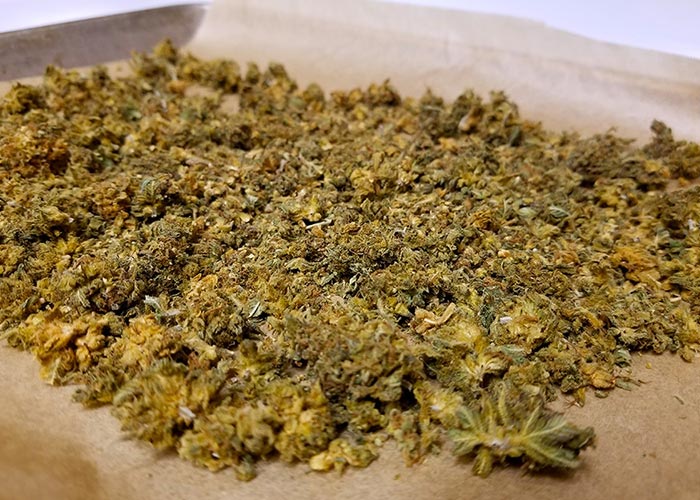Here at Green Goods, we’ve written a great deal on the science of cannabis, how compounds such as cannabinoids and terpenes elicit such powerful effects in our bodies and make cannabis such a uniquely effective medicine. But as we’re sure you’re aware, reading about cannabis and actually using it to make potent (and therapeutic) products are two very different things. That’s why in today’s post, we’d like to introduce the concept of decarboxylation.
Cannabis decarboxylation is a simple process but an essential one: It’s how cannabinoids such as THC transform to provide the effects people seek out to support their health and recreation. Once you understand how to decarb cannabis, you can use it to create your own THC-based tinctures, cannabis edibles, topicals, and other products from the comfort of your own kitchen.
Ready? Let’s get cooking!
Cannabis Decarboxylation: Why Would You Do It?
If you’ve visited our cannabis blog, you know that the cannabis plant contains literally hundreds of active compounds, each of which has the potential to impart different medical and subjective effects. For today’s post, we’re going to stick to the cannabinoids, the family of compounds including THC, CBD, CBN, CBG, and others still.
Cannabinoids interface with our body through a network called the endocannabinoid system, or “ECS,” and it’s an important one. While the ECS wasn’t even identified until the 1990s, many researchers now believe it’s one of the body’s most crucial networks, helping to modulate memory and learning, sleep, and immune response, among other vital functions. But here’s the rub: Until THC undergoes decarboxylation, it won’t enact the intoxicating effects many people expect. While THCA offers potential beneficial effects, it won’t get you high. If you know someone who’s ever munched down on a handful of raw cannabis flower, you know exactly what we’re talking about here.

Why? Cannabinoids that you’ve likely heard of, such as THC and CBD, actually don’t occur in raw cannabis flower. Instead, they take the form of precursor molecules, in this case THCA and CBDA. We’ve written previously about THCA, and how while this essential building block to THC won’t get you high, thought it may impart important health benefits of its own. CBD, of course, won’t get you high either, but the same thing goes for this crucial “second cannabinoid.” No decarboxylation? Different compounds with different (though sometimes overlapping) effects.
On a technical level, the decarboxylation of THCA and other cannabinoids forces the molecule to lose a carboxyl group while retaining a crucial hydrogen atom. This typically happens with the application of heat (like when vaping or smoking, for example) or as a natural part of cannabinoid degradation over time.
Not a chemist? Don’t sweat it. On a practical level, all decarboxylation involves is heating dried cannabis flower under carefully controlled conditions. Here’s how to do it.
How to Decarb Cannabis: A Step-By-Step Guide
As we hinted earlier, cannabis decarboxylation is simpler than it sounds. The items you’ll need include:
- Fresh cannabis flower (try starting with roughly half an ounce)
- An oven
- A separate oven-safe thermometer (optional, but highly useful)
- A container to store the decarbed cannabis, such as an 8-ounce Mason jar
Begin by preheating your oven to anywhere in the 220°F – 235°F degree range. If you have that oven-safe thermometer handy, now’s the time to use it. The internal thermostats in ovens typically aren’t very accurate.
We recommend you grind your cannabis flower first. Why? Grinding exposes more of the surface area of the flower to the heat inside the oven. This means that the cannabis decarboxylation will be more even (and more effective). If you have a purpose-made cannabis grinder, now’s the time to use it. But if you don’t, no need to sweat it. Use the sharp edge of a kitchen knife to chop your flower finely (or the broad flat side to crush it) and you’ll still get adequate results. Alternatively, you can use a spice grinder (provided you’re okay with it smelling like cannabis for a few weeks afterwards!).

How much should you use? There’s no required quantity when decarbing, and you can use as much or as little cannabis as you like. We recommend at least enough to half-fill an eight-ounce Mason jar if your intention is to use your decarbed cannabis to make edibles or tinctures at home. That’s roughly half an ounce, depending on several factors.
Once the oven has reached your target temperature, spread the ground cannabis flower evenly into an ovenproof container and place it inside the oven. Set a timer and let the flower bake for 45 minutes in order to achieve full decarboxylation. After the time has elapsed, take out the container, let it cool, and inspect it. The flower should look lightly toasted and dry. Congratulations: you’ve successfully achieved THC decarboxylation!
We should point out there are other ways to achieve decarboxylation. If you’re planning on making a cannabis tincture using glycerin or an oil such as MCT, you can submerge the raw, finely ground flower in the liquid directly in a saucepan on the stovetop (don’t do this with an alcohol-based recipe, due to the danger of fire).
If you decide to go this route, you’ll want to keep a close eye on the temperature using a submersible candy thermometer. Don’t let the temperature exceed 250°F. Why? As the temperature creeps higher, you run the risk of degrading the decarbed cannabinoids such as THC. After 45 minutes, you can consider the cannabis fully decarboxylated and remove it from the oil using a fine strainer.
You can also use a boilable plastic bag to gently “poach” the ground flower in a simmering stovetop water bath. While you’ll need to procure special kitchen-safe bags with this technique, there are a couple of benefits. For one thing, because boiling water only reaches a maximum temperature of 212°F, you don’t run the risk of overheating the cannabis flower. For another, this preserves a higher proportion of the aromatic terpenes that give different strains of cannabis their characteristic flavor profiles.
Whichever method you choose, now that you’ve got a quantity of decarbed cannabis, it’s time for the fun part: deciding what to make with it! The two “building block” recipes we suggest are making your own tincture or your own cannabutter (or cannaoil).
How To Use Decarbed Cannabis: Making Cannabis Tincture
Cannabis tincture couldn’t be easier to make, though it does require a bit of patience. Place your decarbed cannabis inside an 8-ounce Mason jar and cover it with the neutral liquid of your choice. You could use a high-proof alcohol such as vodka or Everclear, or an oil called “medium-chain triglyceride,” better known as MCT. Typically made from coconut oil, MCT is neutral-tasting and carries its own potential benefits (such as being a heart-healthy source of energy).
A third choice is food-grade glycerin, also known as “glycerol” or “glycerine.” Glycerin is an odorless, clear liquid and has a mild, sweet taste with a syrup-like consistency. It’s typically made from soybean, coconut or palm oils. Whichever medium you use, be sure to fill the Mason jar at least an inch or so above the level of the decarboxylated flower.
Now comes the hard part: the waiting. Screw the cap on tightly and leave the jar someplace dark such as a pantry or closet for 4 to 6 weeks, remembering to shake the jar well at least once a day. After those weeks have passed, strain the tincture through a very fine filter or cheesecloth. And there you have it—your own homemade cannabis tincture!
THC Decarboxylation: Making Cannabutter or Cannaoil
If you want to make your own cannabis edibles, cannabis-infused butter or oil are excellent ingredients to have on hand. Note that when using cannabutter or cannaoil in edibles, you will probably end up with a fairly pronounced “weed” flavor—which may (or may not) be what you want your finished dishes to have.
Making infused butters and oils is simple. Combine the half ounce of cannabis you decarboxylated earlier with roughly two cups of melted butter (or the cooking oil of your choice) in a double-boiler or a slow cooker. You’re going to be heating them both on the “low” or “warm” setting for several hours.
Alternatively, you can do this in a saucepan on the stovetop, but this requires regular checking and monitoring the mixture’s temperature with a thermometer to be sure the oil isn’t reaching too high a temperature or burning. Keep temperatures between 175°F and 190°F.
Let the cannabis infusion cook for as long as you can. We recommend 4 – 6 hours in a slow cooker, 6 – 8 hours in a double-boiler, and at least 3 hours in a saucepan.
Once the time’s elapsed, let the cannaoil cool enough so it’s safe to handle. Then carefully pour it through a kitchen strainer, ideally one lined with cheesecloth. It’s tempting to squeeze the plant solids, but don’t. This only adds more chlorophyll (and that “weed flavor”), and not more THC.
That’s it! Stored on a dark pantry shelf, your delicious cannaoil or cannabutter should keep at least 2 months (and roughly twice as long if it’s stored in an airtight jar in the refrigerator).
How to Decarb Cannabis: Final Thoughts
We hope you’ve enjoyed this guide as much as we’ve enjoyed creating it! The decarboxylation of THCA and other acidic cannabinoids is a simple and easy process that anyone can do at home. Plus, you now have the power to create your very own custom tinctures, cannabis edibles, and other products.
If you’re interested in trying some ready-made edibles and other expertly crafted cannabis products, we’d love to help. Start by choosing your location, then check the online menu to see what’s in stock at your local Green Goods dispensary. And if you have any questions about cannabis decarboxylation, don’t hesitate to ask. We’re here to help!
